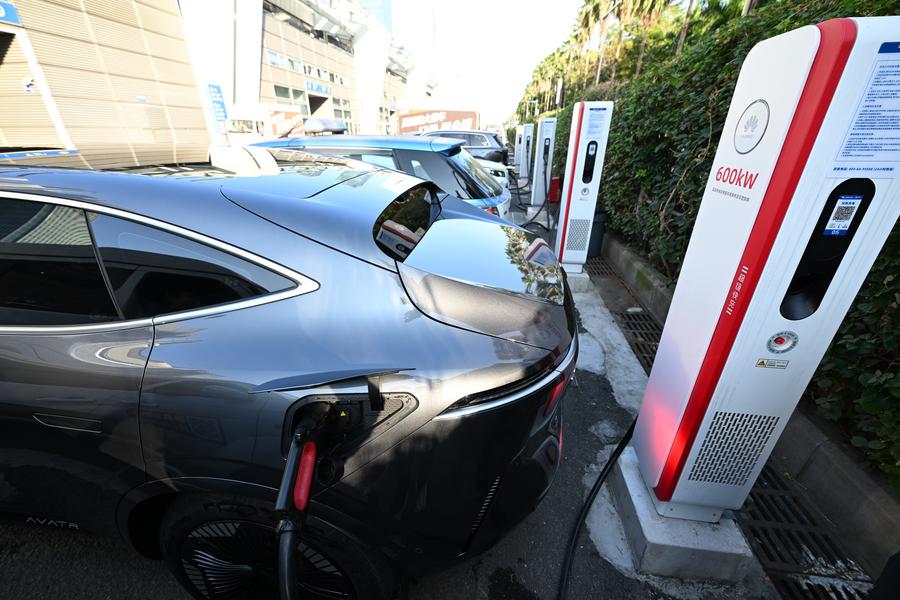
This photo taken on Nov. 28, 2023 shows new energy vehicles (NEVs) recharged with 600-kilowatt chargers at the supercharging station of the Shenzhen Convention and Exhibition Center in Shenzhen, south China's Guangdong Province. (Xinhua/Mao Siqian)
As you plug your electric vehicle into a supercharger stall in Shenzhen, China's tech hub, you find yourself marveling at the rapid movement of the charging progress bar on the car's dashboard.
At the brand new Lianhuashan supercharging station in Shenzhen, a driver of a new energy vehicle (NEV) surnamed Sun unplugged the charging cable and remarked, "I've got nearly 500 km of range in roughly 20 minutes, and the range is enough for my daily commute and weekend outings for two weeks."
"Recharge over a cup of coffee before hitting the road" is the slogan seen at many NEV supercharging stations that have recently sprung up in the city in south China's Guangdong Province. In June 2023, Shenzhen debuted its first fully liquid-cooled supercharging demonstration station and unveiled an initiative that seeks to establish Shenzhen as the "City of Supercharging" by 2030.
By the end of April, the city, home to approximately 18 million permanent residents as well as the prominent NEV producer BYD, had installed 362 supercharging facilities, surpassing the number of petrol stations. The latest available statistics put the number of supercharging stations in the city at 670 and Shenzhen plans to expand the number to 1,000 by the end of this year.

This undated photo shows a production line of new energy vehicles (NEVs) of BYD in Shenzhen, south China's Guangdong Province. (BYD/Handout via Xinhua)
As the tech hub leads the push for ultra-fast charging of NEVs, another tipping point was reached in the automotive sector, highlighting the growing dominance of NEVs over traditional fuel-powered vehicles across the country.
China's NEV sector surpassed the market share of fuel-powered cars for the first time in July. Retail sales of NEVs nationwide reached 878,000 units in July, accounting for 51.1 percent of the total market, according to data released by the China Automobile Dealers Association.
Behind this milestone, the country's ongoing efforts to enhance charging infrastructure have played a crucial role in easing drivers' "range anxiety," which in turn has significantly boosted NEV adoption.
The availability of supercharging makes NEVs a more appealing choice as it significantly shortens charging time. While it usually takes seven to eight hours to charge a vehicle using a slow charging pile, and one to two hours using a fast charging pile, a supercharger is capable of charging an electric vehicle to 80 percent or above within 10 minutes -- adding up to one kilometer of range per second.
"For me, the biggest concern for driving an electric car was the slower charging speed compared to gas refueling. However, this concern has been dispelled by the option of supercharging," said Sun.
Shenzhen is home to more than one million NEVs, which accounts for a quarter of its entire vehicle fleet. During the first half of 2024, the penetration rate of NEVs in Shenzhen reached 72.6 percent -- approximately 72 out of every 100 newly registered vehicles in Shenzhen were NEVs -- well above the national level.
The city boasts over 360,000 public charging piles, an equivalent of roughly 180 piles per square kilometer. Most of the new superchargers are built upon existing public charging facilities and are distributed in large business complexes, bus stations and industrial parks across the city.
Across the country, other megacities are also installing supercharging facilities and developing roadmaps for building supercharging networks. Southwest China's Chongqing Municipality plans to build more than 2,000 supercharging stations for NEVs by 2025. Beijing plans to install 1,000 supercharging stations by the end of 2025.

A driver uses a 600-kilowatt charger to recharge his new energy vehicle (NEV) at the supercharging station of the Shenzhen Convention and Exhibition Center in Shenzhen, south China's Guangdong Province, Nov. 28, 2023. (Xinhua/Mao Siqian)
In a policy interpretation issued in August, Beijing Municipal Commission of Development and Reform said, that Chinese consumers are increasingly expecting "on-the-go" charging experiences similar to gas refueling. The efficiency of charging services, in particular, affects consumer's decision-making when it comes to car purchases.
The supercharging technology and a social service network centered on it are crucial to the appeal of NEVs, according to the authorities.
A Chinese industrial research institute named Forward published an analysis report and tallied that as of mid-June, the number of supercharging stations in China had exceeded 7,700, citing data retrieved from Chinese mobile mapping service Gaode Map. Guangdong Province topped the league table in terms of the number of such facilities.
The year 2024 will be the inaugural year for the implementation of supercharging related standards, said Li Yangxing, vice president of R&D at Sunwoda EVB Co., Ltd, a new energy technology company, adding high-power charging stations will dominate future landscape of public charging infrastructure.
"We found during our investigation that consumers are willing to pay more to upgrade to superfast charging. If their vehicles can achieve a 200-km range in just 5 minutes of charging, consumers are willing to pay up to 6,500 yuan (about 905.5 U.S. dollars) to adapt their vehicles to the charging facilities," Li said.
Forward forecasted that production at scale and the extensive construction of supercharging stations are expected to further drive down unit costs, which will contribute to the extensive adoption of supercharging.
As the government continues to intensify its support for the new energy sector, the construction and operation of supercharging stations can be guaranteed, according to the institute.
















